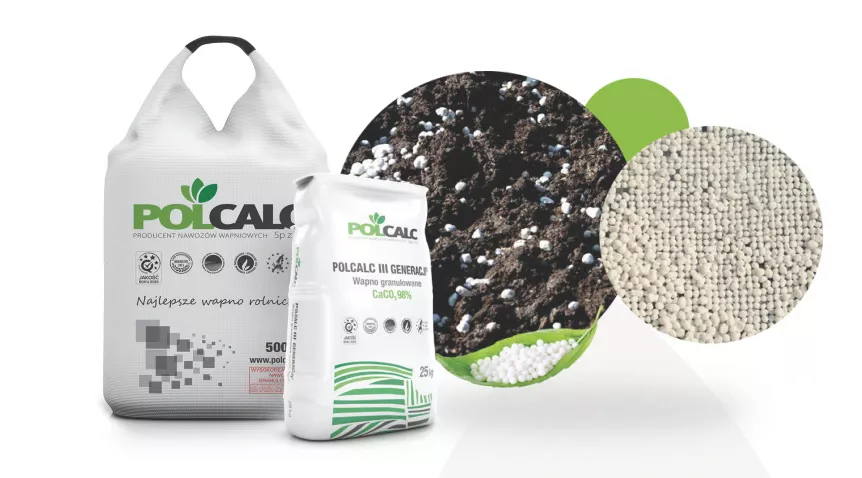
WHAT LIME WILL HELP ACHIEVE BETTER YIELDS?
When choosing a lime fertilizer for your crops, it is best to consider its composition. The best products are made from lime meal, which ensures high-quality fertilizer. The main types of lime fertilizers that can deacidify the soil are oxide lime, carbonate lime, dolomite lime, magnesium lime, and granulated lime.
Each of these lime fertilizers differs slightly in their effect on the soil. Oxide lime works well on acidic and heavy soils, especially when applied frequently in small doses. On the other hand, carbonate lime can be used for acidic, very acidic, as well as lighter and heavier soils. If the soil also has magnesium deficiencies, lime-magnesium fertilizers can be sown on it, e.g., dusty Radkowit, Radkowit Premium, as well as granulated SuperMag.
Lime sown in the field can have two forms: dusty and granulated. The latter is increasingly preferred by farmers. Granulated lime has the advantage of being easier to spread and does not produce as much dust as traditional structures.
WHAT IS THE EFFECT OF GRANULATED LIME?
Before applying any fertilizer, it is worth conducting soil testing. Taking a soil sample and submitting it to a laboratory allows us to determine its pH and identify nutrient deficiencies. This allows for the application of the appropriate type of fertilization.
Granulated lime deacidifies the soil and improves crop yields. It is necessary to know the plants’ requirements well to provide them with pH adjusted to their needs. Granulated lime works best on acidified soils. It is also necessary to repeat the liming treatment, as lime is washed out of the soil under the influence of rainfall.
Granulated lime is more convenient to spread. Its small particles dissolve well in water. As a result, they easily penetrate deep into the soil, deacidify it, and help plants better absorb nutrients from the soil and other fertilizers. Granulated lime, e.g., Polcalc III Generation, also has properties that help plants resist various diseases.
WHEN TO SOW GRANULATED LIME IN THE FIELD?
The best time to sow granulated lime is about a month before the planned sowing of seeds. In practice, soil liming is most often carried out in autumn after harvests or very early in spring. This is the period when lime can interact properly with the soil and produce the expected effects.
Liming should not be done during plant growth, as this may cause more harm than benefit to the crops. An exception to this rule is carbonate granulated lime, e.g., Polcalc III Generation or SuperMag (carbonate granulated lime with absorbable magnesium). Before liming the soil, its examination is necessary to know the extent of acidification and the lime dose to apply.
Annual sowing of granulated lime is also necessary, as soil properties change under the influence of atmospheric factors and human activity (planting, fertilizing, plowing the field).
Plant preferences should also be taken into account. Some of them grow in deacidified soil, while others prefer acidic soil. Therefore, if cucumbers, pumpkins, tomatoes, carrots, peas, or parsley are to be grown in the field, lime treatment can be carried out a year before sowing or planting these plants.
HOW TO CHOOSE GRANULATED LIME?
The best-granulated lime is made from pure raw material – limestone rocks, which are mined in open-pit mines. Such raw material is crushed into a lime meal. This ensures the high reactivity of lime fertilizer. In the case of carbonate lime Polcalc III Generation, the limestone is extremely crushed – 90% of the grain size of a lime meal ranges from 0.02 mm to 0.06 mm. Then lime meal undergoes a granulation process.
High-quality lime should contain over 90% pure CaCO3, although it is usually converted to oxide mass on packaging. Its content should be in the range of 50 to 55% CaO.
In addition to the above-mentioned lime fertilizer, chalk is also included in the granulate form. It contains 30% CaO. It is called meadow chalk. It is easily absorbed by the soil. During the production process, it must be dried, and during this process, granulated.
It is worth knowing that granules do not include pellets made of crushed and rolled dolomite or other stones.
Granulated (carbonate) lime should not be sown together with:
- phosphate meal,
- urea,
- oxide lime.
- The interval between these fertilizers should be about 2-3 weeks. If, for example, manure is to be applied to the field, the interval between manuring the field and liming should be at least 4-6 weeks.
The mentioned granulated lime fertilizers, such as Polcalc III Generation and SuperMag, are produced by Polcalc Lime Fertilizers Ltd. from extremely crushed meals, which makes them characterized by high reactivity.
Detailed information about the products can be obtained from our official distributors and on our website www.polcalc.pl.






